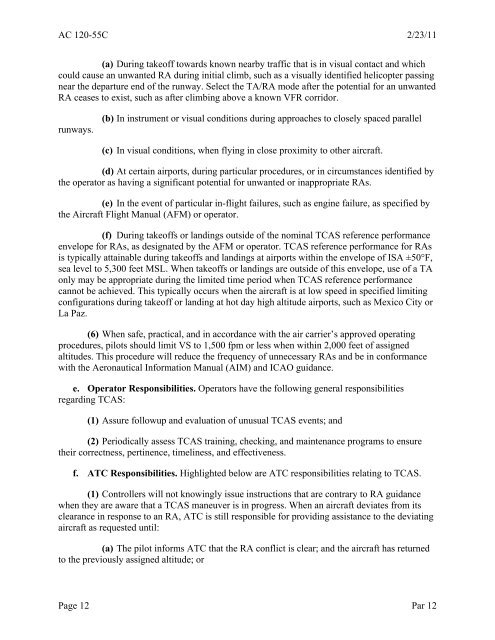AC 120-55C Air Carrier TCAS - Code7700
AC 120-55C Air Carrier TCAS - Code7700
AC 120-55C Air Carrier TCAS - Code7700
Create successful ePaper yourself
Turn your PDF publications into a flip-book with our unique Google optimized e-Paper software.
<strong>AC</strong> <strong>120</strong>-<strong>55C</strong> 2/23/11(a) During takeoff towards known nearby traffic that is in visual contact and whichcould cause an unwanted RA during initial climb, such as a visually identified helicopter passingnear the departure end of the runway. Select the TA/RA mode after the potential for an unwantedRA ceases to exist, such as after climbing above a known VFR corridor.runways.(b) In instrument or visual conditions during approaches to closely spaced parallel(c) In visual conditions, when flying in close proximity to other aircraft.(d) At certain airports, during particular procedures, or in circumstances identified bythe operator as having a significant potential for unwanted or inappropriate RAs.(e) In the event of particular in-flight failures, such as engine failure, as specified bythe <strong>Air</strong>craft Flight Manual (AFM) or operator.(f) During takeoffs or landings outside of the nominal <strong>TCAS</strong> reference performanceenvelope for RAs, as designated by the AFM or operator. <strong>TCAS</strong> reference performance for RAsis typically attainable during takeoffs and landings at airports within the envelope of ISA ±50°F,sea level to 5,300 feet MSL. When takeoffs or landings are outside of this envelope, use of a TAonly may be appropriate during the limited time period when <strong>TCAS</strong> reference performancecannot be achieved. This typically occurs when the aircraft is at low speed in specified limitingconfigurations during takeoff or landing at hot day high altitude airports, such as Mexico City orLa Paz.(6) When safe, practical, and in accordance with the air carrier’s approved operatingprocedures, pilots should limit VS to 1,500 fpm or less when within 2,000 feet of assignedaltitudes. This procedure will reduce the frequency of unnecessary RAs and be in conformancewith the Aeronautical Information Manual (AIM) and ICAO guidance.e. Operator Responsibilities. Operators have the following general responsibilitiesregarding <strong>TCAS</strong>:(1) Assure followup and evaluation of unusual <strong>TCAS</strong> events; and(2) Periodically assess <strong>TCAS</strong> training, checking, and maintenance programs to ensuretheir correctness, pertinence, timeliness, and effectiveness.f. ATC Responsibilities. Highlighted below are ATC responsibilities relating to <strong>TCAS</strong>.(1) Controllers will not knowingly issue instructions that are contrary to RA guidancewhen they are aware that a <strong>TCAS</strong> maneuver is in progress. When an aircraft deviates from itsclearance in response to an RA, ATC is still responsible for providing assistance to the deviatingaircraft as requested until:(a) The pilot informs ATC that the RA conflict is clear; and the aircraft has returnedto the previously assigned altitude; orPage 12 Par 12
















